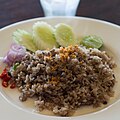| Canarium album | |
|---|---|
 | |
| Canarium album leaves and fruit | |
| Scientific classification | |
| Kingdom: | Plantae |
| Clade: | Tracheophytes |
| Clade: | Angiosperms |
| Clade: | Eudicots |
| Clade: | Rosids |
| Order: | Sapindales |
| Family: | Burseraceae |
| Genus: | Canarium |
| Species: | C. album |
| Binomial name | |
| Canarium album | |
| Synonyms [3] | |
| |
Canarium album is a species of flowering plant in the family Burseraceae . [2] [4] This tree is native in Cambodia, China, Laos, and Vietnam. [2] The Catalogue of Life does not record any sub-species. [4]
Contents
Canarium album produces a fruit commonly called Chinese olive or white olive, [5] though it has no relation to Olea ; it is consumed in Vietnam (Vietnamese: trám trắng, fruit quả trám), Thailand (where it is known as samo chin (Thai : สมอจีน) or kana (Thai : กาน้า)) and in China (simplified Chinese :橄榄; traditional Chinese :橄欖; pinyin :gǎnlǎn). [6]
The pulp of the tree's fruit and its seeds are edible, with a strong resinous flavor when they are fresh. Culinary oil can be extracted from the seed. Preserves can be made with the fruit, both sweet like jam or pickled preserves. In China, a pickle called olive vegetable (simplified Chinese :橄榄菜; traditional Chinese :橄欖菜; pinyin :gǎnlǎn cài), made from a mix of Canarium album fruit and mustard greens, is commonly used as a flavoring for congee and fried rice, [7] with Teochew people specifically being very fond of the pickle.
Mostly cultivated in Thailand, cultivation has been introduced on a smaller scale to Fiji and northern Queensland in Australia. Its fruit, resin and seed are exported to Europe where they are used in the manufacture of varnish and soap. [8]


